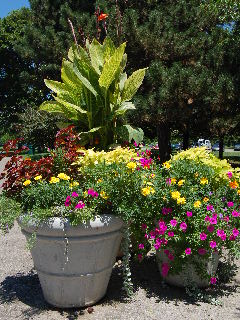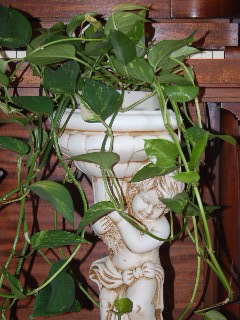
Whether you plan to grow houseplants on the windowsill or potted plants on the patio, you’re going to have to decide what kind of containers to use. Let’s take a look at what is available to you in terms of types of plant containers and the pros and cons of using these different materials.
The most commonly used materials for plant pots are plastic, natural clay, ceramic or glazed clay, metal, wood, and concrete. The cost of containers made from any of these materials will depend on their size, shape, quality, strength, and the workmanship involved (mass produced or hand-painted, etc.).
Let’s look at plastic first; generally the least expensive material for mass-produced plant containers. One big advantage of plastic, other than its low cost, is that you have a huge array of sizes, colors, and styles of pots to choose from. This enables you to find just the right container to suit your needs in terms of matching the pot size to the plant size and matching the pot to the décor of the surroundings in which your container will reside. On the negative side, plastic is easily broken or scratched; and since it is cheap, it sometimes looks cheap. Also, it has no porosity to allow the soil to breathe or to help absorb moisture for the plant roots.
What about natural clay? This is the classic plant container; the ever dependable, unassuming, available in all sizes, brownish-red, not too expensive workhorse that seems to have been around since gardening first began. In fact, some historians believe the first “honey-do” request may have been uttered by Eve when she said to Adam, “Hold off on that apple, and let’s pot some of these nice plants to bring indoors before the weather changes!”
Clay pots are the ultimate Earth-friendly container, being made from natural clay rather than from synthetic materials; they are quite porous and help promote air and water movement to the plant roots. Their porosity, in fact, makes it easy for you to water your plants from the bottom by filling the tray with water, and allowing the water to “wick” up through the soil and through the sides of the plant container itself. Just be sure your clay tray has some sort of non-porous material between its bottom and the top of your nice furniture, so the moisture will not be drawn into the tabletop’s finish.

While we’re talking about clay, let’s mention concrete as well, since it has most of the same desirable properties as clay, those being its porosity, natural appearance, and Earth-friendly make-up. The negatives are its weight and the fact that it will deteriorate outside in the freezing weather, which makes moving it into the garden shed in winter a necessity. Ouch, my back!
Back to clay. We can get fancier (and deeper into your pocketbook) with glazed ceramic finishes that are elegantly decorated and often hand-painted. These look great, but require gentle care to avoid breaking or chipping. The sealed finish causes the pots to loose their porous nature; the slickness looks nice, but it doesn’t maximize the efficiency of the container in the movement of air and water to the plant roots.
And while we’re talking about slick and fancy, maybe even elegant and stately, how about metal for a plant container; brass looks great but be prepared to polish the pot if you want it to retain its lustrous sheen. Appearance is probably the greatest positive in using brass or other metal alloy containers. Ferns, palms, ivy, or other greenery in a nicely shaped brass container lends an elegant touch to your living room or library.
What about wooden containers for your plants? These are okay in some cases, mostly outdoors. We’ve all seen the big wooden kegs (from whiskey distilleries?), cut in half and available at garden centers. You can load them up with potting soil and create a colorful container of annuals with maybe some ivy or other trailing greenery spilling over the sides. Be sure your barrel is located where you want it before you fill it with soil (heavy), and be careful of stains created from water draining down through your barrel, especially if you choose to locate it on the surface of your nice wooden deck. Other wooden containers are available, too. Some of the cedar or redwood-looking planters are attractive and generally quite weather resistant.
So, those are the basic choices. Choose what looks good to you for the site your pot will occupy and for the money you want to spend. Think about the color of your container as related to the color of the blooms on the plant and the colors in your room if you are preparing a houseplant. If all container choices seem equal, then choose the old reliable, the gardener’s friend—the classic clay pot. Your friends will admire your good judgement!
 Whether you plan to grow houseplants on the windowsill or potted plants on the patio, you’re going to have to decide what kind of containers to use. Let’s take a look at what is available to you in terms of types of plant containers and the pros and cons of using these different materials.
Whether you plan to grow houseplants on the windowsill or potted plants on the patio, you’re going to have to decide what kind of containers to use. Let’s take a look at what is available to you in terms of types of plant containers and the pros and cons of using these different materials.
 While we’re talking about clay, let’s mention concrete as well, since it has most of the same desirable properties as clay, those being its porosity, natural appearance, and Earth-friendly make-up. The negatives are its weight and the fact that it will deteriorate outside in the freezing weather, which makes moving it into the garden shed in winter a necessity. Ouch, my back!
While we’re talking about clay, let’s mention concrete as well, since it has most of the same desirable properties as clay, those being its porosity, natural appearance, and Earth-friendly make-up. The negatives are its weight and the fact that it will deteriorate outside in the freezing weather, which makes moving it into the garden shed in winter a necessity. Ouch, my back!